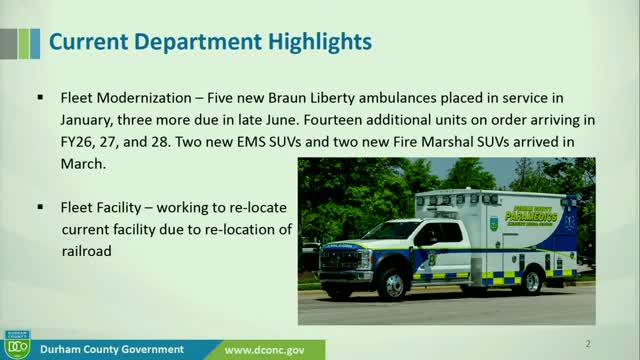Durham County officials outline emergency services funding and staffing challenges
May 22, 2025 | Durham County, North Carolina
This article was created by AI summarizing key points discussed. AI makes mistakes, so for full details and context, please refer to the video of the full meeting. Please report any errors so we can fix them. Report an error »

The Durham County Board of Commissioners (BOCC) held a budget work session on May 22, 2025, focusing on various operational challenges and funding needs across county departments. The meeting addressed critical issues including facility relocations, emergency services funding, and staffing requirements.
The session began with discussions on the relocation of a current facility due to railroad construction, which necessitates vacating the area by December 1. County officials expressed gratitude for the collaboration with General Services and other stakeholders in finding a new location.
A significant portion of the meeting was dedicated to the ongoing communications modernization project. The Office of Emergency Services (OES) reported that new portable radios, funded by a previous request, have been received and are being programmed for use. These radios will enhance interoperability among public safety agencies and comply with state mandates, with a deadline for implementation set for July 1.
The OES also highlighted an increase in workload due to rising call volumes, with a 2-3% annual increase noted. Since fiscal year 2021, call volumes have surged by 16%, and by 24.7% since fiscal year 2018. The department is currently managing low-priority calls, which constitute about 5% of weekly call volume.
In terms of fire prevention, the department reported progress in inspecting high-hazard areas and catching up on statutory inspection schedules. However, challenges remain regarding blasting issues, which are still being addressed in collaboration with the City of Durham Fire Department.
A key topic of discussion was the impact of the North Carolina Medicaid transformation program on county revenues. The introduction of tailored plans is expected to affect billing and revenue collection, with approximately $2.3 million currently in the pipeline awaiting processing. Officials expressed optimism that these funds could be realized in fiscal year 2026.
The meeting also covered staffing needs within the OES. Requests included a senior auto mechanic position and a deputy chief for emergency management to address growing challenges. Additionally, the EMS team requested 12 new positions (6 EMTs and 6 paramedics) and five replacement ambulances to manage increasing call volumes effectively.
The discussion concluded with an overview of response times and call handling. The average response time for emergency calls has fluctuated around the 10-minute mark, with a 90% response time average exceeding 16 minutes. Officials acknowledged the need for improved patient outcomes and indicated that the current staffing model may not be sustainable given projected community growth.
Overall, the meeting underscored the pressing need for additional resources and staffing to meet the demands of Durham County's emergency services and public safety operations. The BOCC will continue to evaluate these needs as they finalize the budget for the upcoming fiscal year.
The session began with discussions on the relocation of a current facility due to railroad construction, which necessitates vacating the area by December 1. County officials expressed gratitude for the collaboration with General Services and other stakeholders in finding a new location.
A significant portion of the meeting was dedicated to the ongoing communications modernization project. The Office of Emergency Services (OES) reported that new portable radios, funded by a previous request, have been received and are being programmed for use. These radios will enhance interoperability among public safety agencies and comply with state mandates, with a deadline for implementation set for July 1.
The OES also highlighted an increase in workload due to rising call volumes, with a 2-3% annual increase noted. Since fiscal year 2021, call volumes have surged by 16%, and by 24.7% since fiscal year 2018. The department is currently managing low-priority calls, which constitute about 5% of weekly call volume.
In terms of fire prevention, the department reported progress in inspecting high-hazard areas and catching up on statutory inspection schedules. However, challenges remain regarding blasting issues, which are still being addressed in collaboration with the City of Durham Fire Department.
A key topic of discussion was the impact of the North Carolina Medicaid transformation program on county revenues. The introduction of tailored plans is expected to affect billing and revenue collection, with approximately $2.3 million currently in the pipeline awaiting processing. Officials expressed optimism that these funds could be realized in fiscal year 2026.
The meeting also covered staffing needs within the OES. Requests included a senior auto mechanic position and a deputy chief for emergency management to address growing challenges. Additionally, the EMS team requested 12 new positions (6 EMTs and 6 paramedics) and five replacement ambulances to manage increasing call volumes effectively.
The discussion concluded with an overview of response times and call handling. The average response time for emergency calls has fluctuated around the 10-minute mark, with a 90% response time average exceeding 16 minutes. Officials acknowledged the need for improved patient outcomes and indicated that the current staffing model may not be sustainable given projected community growth.
Overall, the meeting underscored the pressing need for additional resources and staffing to meet the demands of Durham County's emergency services and public safety operations. The BOCC will continue to evaluate these needs as they finalize the budget for the upcoming fiscal year.
View full meeting
This article is based on a recent meeting—watch the full video and explore the complete transcript for deeper insights into the discussion.
View full meeting
